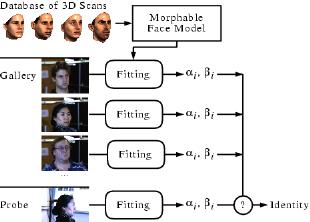| Computer Vision | |||||||
| Model-Based Face Recognition . In collaboration with: T. Vetter, Universität Basel. | |||||||
| Recognition of Faces across changes in pose and illumination is one of the most challenging problems in Computer Vision. Our approach uses the model coefficients of a 3D Morphable Model for representing the identity of a person. These coefficients describe the 3D shape and surface colors (texture), based on the statistics observed in a dataset of examples. Since 3D shape and texture are independent of viewing angle, the representation depends little on the specific imaging conditions. | |||||||
| We estimate the model coefficients by fitting the Morphable Model to the input images: Starting from the average face in a frontal pose and in the center of the image, our fitting algorithm calculates for each model coefficient and for the imaging parameters, such as rotation angles, how they affect the difference between the synthetic image of the model, and the input image. Then, all values are updated such that the image difference is reduced, until our model reproduces the color values found in the original image. In order to identify a person, we compare the model coefficients with those of all individuals "known" to the system, and find the nearest neighbor. | |||||||
| An evaluation on two large datasets shows that identification rates of 95% and 95,9%, respectively, can be achieved even across large changes of both viewing angle and illumination. | |||||||
 |
|||||||
| Lit: V. Blanz and T. Vetter, Face Recognition based on Fitting a 3D Morphable Model. IEEE Trans on Pattern Analysis and Machine Intelligence 25 (9), pp 1063-1074, 2003. |
|||||||
| |
|||||||
© Universitiy of Siegen, Chair of Media Informatics 2022© Sascha Nesch 2009